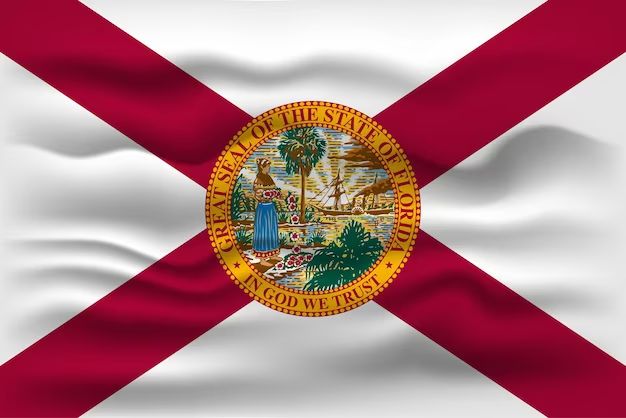Florida, known as the Sunshine State, is located in the southeastern region of the United States. It is bordered by Alabama and Georgia to the north, the Atlantic Ocean to the east, the Gulf of Mexico to the west, and has a coastline along the Straits of Florida and the Caribbean Sea. Florida is the 22nd most extensive state, covering 65,755 square miles, and is the 3rd most populous state with over 21 million residents. Florida has a diverse geography and climate, historic attractions, a booming tourism industry, and unique wildlife. Like every other state, Florida has designated official state symbols that represent its culture, heritage, and natural beauty.
Page Contents
Florida’s State Flower – Orange Blossom
The bright, fragrant orange blossom was adopted as Florida’s state flower in 1909. The delicate white petals and soft citrusy fragrance represent the state’s iconic citrus industry. Orange blossoms bloom in the spring on orange trees across Florida, filling the air with their sweet scent. They are strongly associated with the central Florida orange groves found around Orlando and up through citrus-growing regions.
Orange blossoms hold cultural significance in Florida history. Early settlers planted orange trees soon after establishing homesteads. By the late 1800s, Florida became a leading producer of oranges and other citrus fruits. The orange blossom was celebrated through artwork and poetry as a symbol of fertility and the promise of prosperity.
Orange blossom extracts were traditionally used in perfumes, candles, and weddings. Brides often wear orange blossom crowns or carry bouquets decorated with the delicate flowers as a symbol of purity and new beginnings. The orange blossom remains deeply connected to Florida’s identity and economy while bringing beauty and a lovely aroma to the state.
Interesting Facts About the Orange Blossom
- The scientific name for the orange blossom is Citrus sinensis
- Orange blossoms typically bloom in Florida between February and April
- It takes around 3-4 years for an orange tree to produce its first crop of blossoms
- The peak orange blossom season usually lasts 2-3 weeks
- Orange blossoms produce a sweet, citrusy scent that carries on the breeze
- Orange blossoms are traditionally associated with weddings as a symbol of fertility and purity
- Orange blossom honey is produced in Florida from the tree’s nectar
Florida’s State Bird – Northern Mockingbird
The clever and vocal northern mockingbird was designated as the official state bird of Florida in 1927. These medium-sized songbirds measure 8.3–10.2 inches and weigh about 1.6–2 ounces. They have long tails and wings and gray upper bodies. Their undersides are a pale gray or white, and two white wing patches are visible when flying. Northern mockingbirds are known for their intelligence and ability to mimic calls and songs of other birds.
Found year-round in Florida, northern mockingbirds thrive in open areas with scattered trees and shrubs. They commonly nest in thickets, forest edges, parks, and backyards. Northern mockingbirds eat insects, fruits, berries, seeds, and occasionally small lizards or frogs. They aggressively defend their nests and are very territorial.
As Florida’s state bird, the northern mockingbird represents the state’s varied habitats and mild climate that enables the species to flourish. Northern mockingbirds are found across the southern United States and Mexico. Their musical calls echo through Florida’s beaches, wetlands, scrublands, suburbs, and cities. The mockingbird’s intelligence and adaptability have ensured its success among the state’s ecosystems.
Interesting Facts About the Northern Mockingbird
- The scientific name is Mimus polyglottos, meaning “many-tongued mimic”
- Northern mockingbirds can live up to 20 years in the wild
- They get their name from ability to mimic sounds of over 30 other bird species
- Mockingbirds learn new songs throughout their life and like to sing day and night
- A male mockingbird may learn 200 songs in its life to attract a mate and defend territory
- Mockingbirds eat insects, fruits, seeds, and occasionally small lizards or frogs
- They aggressively defend their nests, often diving at intruders
- Northern mockingbirds raised in cities and suburbs adapt songs heard in their environment, including sirens and car alarms
Comparison of the Orange Blossom and Northern Mockingbird
As the official state flower and bird, the orange blossom and northern mockingbird represent distinct aspects of Florida’s culture and ecology. Here is a comparison of the two state symbols:
| Category | Orange Blossom | Northern Mockingbird |
|---|---|---|
| Type | Flower | Bird |
| Scientific Name | Citrus sinensis | Mimus polyglottos |
| Size | 2-3 inches diameter | 8.3-10.2 inches length |
| Habitat | Orange groves, citrus farms | Open country, thickets, forest edges, parks, suburbs |
| Distinguishing Feature | White petals, citrusy fragrance | Mimics songs of other birds, intelligence |
| Cultural Significance | Symbol of fertility and purity, citrus industry | Vocal skill, adaptability, southern heritage |
While very different biologically, both the orange blossom and northern mockingbird beautifully represent key aspects of Florida’s cultural heritage and biodiversity.
Conclusion
The orange blossom flower and the northern mockingbird stand as iconic symbols of the state of Florida. The delicate orange blossom epitomizes the sunny citrus groves that perfume the air and contribute to Florida’s identity and economy. Its symbolic meaning of fertility and purity in weddings and artwork enduringly encapsulates cultural traditions. The clever northern mockingbird with its varied songs echoes through Florida’s diverse ecosystems. Its intelligence, vocal skills, and adaptability to thrive statewide make it the perfect avian representative. The orange blossom and northern mockingbird beautifully encapsulate the Sunshine State’s legacy and natural splendor.
